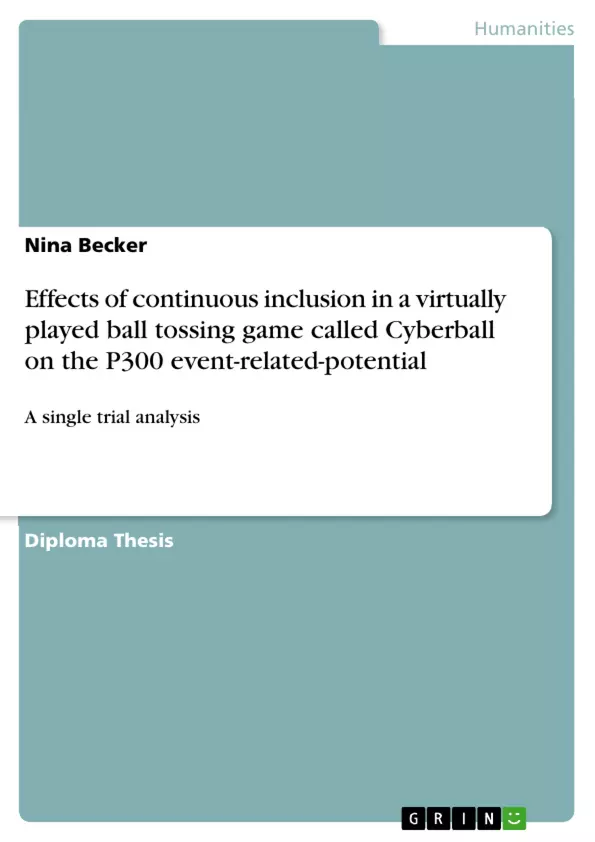The current study investigated effects of continuous social inclusion in a virtual ball tossing game on the P300 event-related potential based on a single trial analysis. Participants played an ostensible online game called Cyberball, which served as a social modification of the classical Oddball Paradigm. During the inclusion session, ball passes to the participant became more frequent over time from almost none to 33% at the very end of the game. Each participant had to ran an inclusion and an exclusion session. According to the order of experimental conditions, two inclusion-groups encompassing 15 datasets were taken for analysis. Of special interest was the centro-parietal P3b subcomponent that emerges 220ms-500ms after stimulus onset. The signal detection technique included template matching and cross-correlation. The data were analyzed twice: Once with the raw data, once preprocessed with the application of the Independent Component Analysis. Performances of the different approaches were compared and evaluated. Effects of target probability changes on the P300 amplitude were investigated. Further a linear fit and a model of local target probability were applied to account for P300 amplitude variations. Latencies were mainly examined to validate the methods of single trial estimations.
Table of Contents
- Abstract
- Introduction
- Introduction
- Ostracism
- Paradigms that Trigger the Feeling of Ostracism
- External and Internal Factors that Moderate Ostracism's Immediate Impact
- The Need Threat Model
- The Ostracism Sensitivity Threshold and Clinical Implications
- Ostracism and Social Inclusion
- Event-Related-Potentials
- P300 Component and the Oddball Paradigm
- P3b Latency
- P3b Amplitude
- A Social Oddball Paradigm
- Single-Trial Analysis and the P300
- Development of the Single Trial Analysis
- Extraction of the Component of Interest
- Independent Component Analysis
- Aim of the Current Study
- Hypothesis
- Materials and Methods
- Participants
- Period of Investigation and Laboratory Environment
- Cyberball Paradigm: Stimulus Sequences and Material
- Experimental Design
- Independent Variable
- Dependent Variable
- Control of Confounding Variables
- EEG Recording
- Electrode Placement and EEG Settings
- Equipment
- Test Execution
- Participant Recruitment
- EEG Preparation
- Procedure
- Data Analysis
- EEG Preprocessing
- Approach 1: Non-ICA correction
- Approach 2: ICA correction
- Template Matching Method
- Statistics
- Effects of Time and Group on the P300 Potential
- Probability Models and the P300 Amplitude
- EEG Preprocessing
- Results
- Effects of Time and Group on the P300 Potential
- Amplitudes
- Latencies
- Probability Models and the P300 Amplitude
- Linear Fit
- Model of Local Target Probability
- Effects of Time and Group on the P300 Potential
- Discussion
- Summary of Results
- Non-ICA Corrected Data
- ICA Corrected Data
- Hypothesis
- Integration of Results in the P300 Literature
- P300 Amplitude
- P300 Latency
- Interpretation of the P300 Component Referring to an Ostracism Detection System
- Summary According to the Method of Single Trial Analysis
- The Approaches of Non-ICA and ICA Correction
- Template Matching Method
- Conclusion
- Critical Review and Prospective Studies
- Summary of Results
- References
Objectives and Key Themes
This study investigates the effects of continuous social exclusion, experienced in a virtual ball tossing game called Cyberball, on the P300 event-related-potential (ERP) component. The objective is to analyze the P300 amplitude and latency in response to inclusion and exclusion conditions using a single-trial analysis approach.- The psychological effects of social exclusion (ostracism)
- The brain's response to social exclusion as measured by the P300 ERP component
- The influence of single-trial analysis on the understanding of the P300 in relation to social exclusion
- The development and validation of a method to analyze the P300 component using single-trial data
- The implications of these findings for understanding social exclusion and its impact on individuals
Chapter Summaries
- Introduction: This chapter provides a comprehensive overview of social exclusion and its effects. It introduces the concepts of ostracism, paradigms that trigger feelings of exclusion, and the Need Threat Model. Additionally, it discusses the role of event-related-potentials (ERPs), particularly the P300 component, in understanding the brain's response to social exclusion.
- Materials and Methods: This chapter details the methodology employed in the study. It outlines the participants, experimental design, Cyberball paradigm, EEG recording procedures, and data analysis methods.
- Results: This chapter presents the findings of the study. It analyzes the effects of time and group on the P300 amplitude and latency, and investigates the influence of probability models on the P300 amplitude.
- Discussion: This chapter interprets the results in light of previous research on social exclusion and the P300 ERP component. It discusses the significance of the findings, limitations of the study, and potential future research directions.
Keywords
This study focuses on the interplay of social exclusion (ostracism), the P300 event-related-potential, single-trial analysis, and the Cyberball paradigm. The research emphasizes the implications of these concepts for understanding the neurobiological underpinnings of social exclusion and its impact on individuals. Key terms include social exclusion, ostracism, Cyberball, P300, event-related-potential, single-trial analysis, and the Need Threat Model.- Citation du texte
- Nina Becker (Auteur), 2011, Effects of continuous inclusion in a virtually played ball tossing game called Cyberball on the P300 event-related-potential, Munich, GRIN Verlag, https://www.grin.com/document/183747



